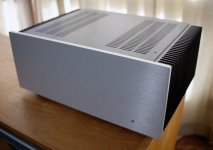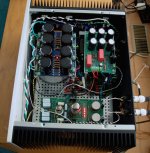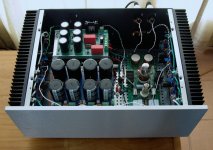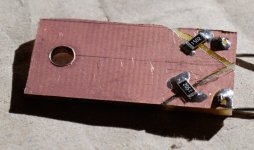What's the thing that looks like a cap with a circle round it? Is it a neon?
yes. those are neon lamps to protect the output cathode followers on startup...
Do you use a particular voltage of neons? I wonder if I have neons right on the verge of firing. I suspect(I've had loads of suspicions) my neons maybe be on the verge of turning on. Although having looked at my grounding, maybe it's the long wires causing my long term issues. Hsssssss. Nothing. Hsssss. Swuuuuuuuuuopp. Nothing. Ckkkkkkkkkkpppp. Nothing. For a while. Etc...
Hi, got the b+ wires twisted.
The noise is very intermittent. However I did try swapping the tubes so I assumed that wasn't the problem but I understand quite a few 6sn7s do suffer from this. I have a couple of newish tung sol, I think the date stamps on them are 05 and 08 so not 1940s ones .
Was thinking of trying an electro harmonix one before going down the somewhat expensive and potentially shady nos route as they're reasonably priced and have generally found eh to be fairly consistant.
Any recommendations?
The noise is very intermittent. However I did try swapping the tubes so I assumed that wasn't the problem but I understand quite a few 6sn7s do suffer from this. I have a couple of newish tung sol, I think the date stamps on them are 05 and 08 so not 1940s ones .
Was thinking of trying an electro harmonix one before going down the somewhat expensive and potentially shady nos route as they're reasonably priced and have generally found eh to be fairly consistant.
Any recommendations?
One advantage of NOS is that they were building a lot more back then and their industrial quality was likely better. That said, I've only bought a few NOS tubes and only from a dealer with a good reputation plus willing and able to test for balance, transconductance, and microphony. If you are looking for low microphony and robust, consider a 5692 if you can find a good one. They are built like a tank and have a good reputation for being quiet. Pricey though.
Jac
Jac
I think I have finally got to the bottom of it. It was the tubes. Although it was the first thing I checked I think I had damaged both tubes at the testing stage. I had run a somewhat hot test signal in and the output when to around 70v pp or so. I think this beyond the limits of the 6sn7.
Never mind, I've learnt loads more by rebuilding most of the circuit several times and really thinking about it.
I've tried a couple of different tubes. I'll be brief
Tung sol reissue. Really nice mid range and instruments sound like instruments. Bass guitars can get lost in lower kids.
Jan Phillips 6sn7wgta: bass much more defined. Mid and treble harsh. Sterile and boring, Didn't stay in long but at least it wasn't making any noise.
Sylvania 6sn7gtb yellow writing d shaped wire getter t plates:vibrant, seems to be pretty good. Treble currently not as smooth as tung sols but certainly hasn't left me disappointed like the Philips did.
Really surprised how different they all sound. Way more than I would have thought.
Never mind, I've learnt loads more by rebuilding most of the circuit several times and really thinking about it.
I've tried a couple of different tubes. I'll be brief
Tung sol reissue. Really nice mid range and instruments sound like instruments. Bass guitars can get lost in lower kids.
Jan Phillips 6sn7wgta: bass much more defined. Mid and treble harsh. Sterile and boring, Didn't stay in long but at least it wasn't making any noise.
Sylvania 6sn7gtb yellow writing d shaped wire getter t plates:vibrant, seems to be pretty good. Treble currently not as smooth as tung sols but certainly hasn't left me disappointed like the Philips did.
Really surprised how different they all sound. Way more than I would have thought.
Square Wave Testing with Input Transformer
For those of you with experience doing the square wave testing on the input of the Impasse or other similar experience, please share the test conditions of your square wave.
Voltage or amplitude?
Frequency?
Bandwidth limited? if so, frequency or slew rate?
Every time I Learn something new, I come up with new questions. The input square wave test conditions appear to be very important for tuning the load on the input transformer of the Impasse.
Square Wave Amplitude
Let me start with the square wave amplitude. My first testing used a square wave input with an amplitude of about 2 V (4 V peak to peak). This seemed a reasonable value about the same as a 2 Vrms sine wave.
Then I started thinking about the amp. The F4 swings 20 volts and the Impasse has a gain of 20. Therefore, I would be at the limit of the F4 if I used a 1 volt square wave. Since the slew rate requirement of the Impasse is a function of input square wave amplitude, I may have used too much voltage in my early tests. Is my reasoning sound?
Frequency
On suggestion of someone earlier in this thread, I am using a 10 KHz input frequency. Good number or do you use something different?
Bandwidth
The F4 has a upper bandwidth limit of 200 kHz and Mr. Pass says it will produce a 100 kHz square wave cleanly. And I believe him.
Rod Elliott of ESP favors a bandwidth limited square wave as the input of square wave testing. He says that music doesn't have the very high slew rates and suggests that an amp that swings +/- 35V only has a slew rate of about 4.4 uV/s.
Mr. Pass says that there are amplitude and phase affects in the ultrasonic range above 20 kHz that affect sound quality.
What is also true is that the higher the frequency, the higher the slew rate, the more likely we will get overshoot or ringing in a square wave response.
Using Mr. Elliott's equation, the F4 at 20V and 200 kHz needs a slew rate of 25 uV/s. The reality is that we won't be close to that frequency with the Impasse and it's input transformers. Cine-mag quotes the f3 point of the transformer at 60 to 80 kHz, depending on load. It seems reasonable to me to limit the input square wave to a slew rate equivalent to the transformer's bandwidth.
Using 80 kHz and 20 V, a slew rate of 10 uV/s is needed. Based on the specs, my signal generator is capable of a maximum slew rate of 167 uV/s. Talk about overkill. Would it makes sense to put a filter on the square wave to limit it's bandwidth to 80 kHz?
I am totally open to discussion here. I would love to get a better handle on how to choose the square wave input parameters. So thanks for your input.
Jac
For those of you with experience doing the square wave testing on the input of the Impasse or other similar experience, please share the test conditions of your square wave.
Voltage or amplitude?
Frequency?
Bandwidth limited? if so, frequency or slew rate?
Every time I Learn something new, I come up with new questions. The input square wave test conditions appear to be very important for tuning the load on the input transformer of the Impasse.
Square Wave Amplitude
Let me start with the square wave amplitude. My first testing used a square wave input with an amplitude of about 2 V (4 V peak to peak). This seemed a reasonable value about the same as a 2 Vrms sine wave.
Then I started thinking about the amp. The F4 swings 20 volts and the Impasse has a gain of 20. Therefore, I would be at the limit of the F4 if I used a 1 volt square wave. Since the slew rate requirement of the Impasse is a function of input square wave amplitude, I may have used too much voltage in my early tests. Is my reasoning sound?
Frequency
On suggestion of someone earlier in this thread, I am using a 10 KHz input frequency. Good number or do you use something different?
Bandwidth
The F4 has a upper bandwidth limit of 200 kHz and Mr. Pass says it will produce a 100 kHz square wave cleanly. And I believe him.
Rod Elliott of ESP favors a bandwidth limited square wave as the input of square wave testing. He says that music doesn't have the very high slew rates and suggests that an amp that swings +/- 35V only has a slew rate of about 4.4 uV/s.
Mr. Pass says that there are amplitude and phase affects in the ultrasonic range above 20 kHz that affect sound quality.
What is also true is that the higher the frequency, the higher the slew rate, the more likely we will get overshoot or ringing in a square wave response.
Using Mr. Elliott's equation, the F4 at 20V and 200 kHz needs a slew rate of 25 uV/s. The reality is that we won't be close to that frequency with the Impasse and it's input transformers. Cine-mag quotes the f3 point of the transformer at 60 to 80 kHz, depending on load. It seems reasonable to me to limit the input square wave to a slew rate equivalent to the transformer's bandwidth.
Using 80 kHz and 20 V, a slew rate of 10 uV/s is needed. Based on the specs, my signal generator is capable of a maximum slew rate of 167 uV/s. Talk about overkill. Would it makes sense to put a filter on the square wave to limit it's bandwidth to 80 kHz?
I am totally open to discussion here. I would love to get a better handle on how to choose the square wave input parameters. So thanks for your input.
Jac
Never Mind
I found my answers. My early searches didn't find any good information, but when I tried starting a new thread to discuss this, they found several threads with a common theme. Especially this thread was helpful, just in case others have these questions. In particular, I like gootee's post #4.
square wave testing and slew rate
Jac
I found my answers. My early searches didn't find any good information, but when I tried starting a new thread to discuss this, they found several threads with a common theme. Especially this thread was helpful, just in case others have these questions. In particular, I like gootee's post #4.
square wave testing and slew rate
Jac
Is there a BOM with part numbers that fit Jack's boards?
Thanks
I think I used the same part numbers as SY, just double the quantity.
Impass + F4 Complete
I seem to be a sucker for a SY project. I like the way he explains his design process and choices in a way that I understand and buy into. A little bit like Papa Pass.
I managed to shoehorn an Impasse and an F4 into the same 4U enclosure. When I first saw the size of the 4U box, I thought it was huge. Then I started looking at how to arrange the pieces and, it may not be the tightest build I've ever done, but its pretty tight. I had to build a couple of "lofts" to float the power supply boards above their respective transformers.
My build is different than the original Impasse design in that I didn't need the pre-amp functions. In this case, the Impasse is operating as a voltage gain stage for the F4. Balanced input and single ended output. For anyone else using Cinemags and no volume control, 10k input impedance resistor with no zobel gave me perfect square waves at 10 kHz.
The thing is heavy. Easily 45 or 50 pounds.
Of course, the F4 gives off heat. I was surprised how much heat was given off by the Impasse. Not only the tubes and CCS transistors, but R11 and R12 run surprisingly hot. I don't quite understand why because they have the correct 120 VDC across them.
I had been worried about noise from having a 350 V transformer inside the box, but hum noise is non-existent. The only noise is a very faint white noise that is probably from one of the tubes. Naturally, lots of wire twisting was involved, but I'm happy with the result.
Its too early to compare sound quality with other amps, but I hope it works as well as advertised.
Jac
I seem to be a sucker for a SY project. I like the way he explains his design process and choices in a way that I understand and buy into. A little bit like Papa Pass.
I managed to shoehorn an Impasse and an F4 into the same 4U enclosure. When I first saw the size of the 4U box, I thought it was huge. Then I started looking at how to arrange the pieces and, it may not be the tightest build I've ever done, but its pretty tight. I had to build a couple of "lofts" to float the power supply boards above their respective transformers.
My build is different than the original Impasse design in that I didn't need the pre-amp functions. In this case, the Impasse is operating as a voltage gain stage for the F4. Balanced input and single ended output. For anyone else using Cinemags and no volume control, 10k input impedance resistor with no zobel gave me perfect square waves at 10 kHz.
The thing is heavy. Easily 45 or 50 pounds.
Of course, the F4 gives off heat. I was surprised how much heat was given off by the Impasse. Not only the tubes and CCS transistors, but R11 and R12 run surprisingly hot. I don't quite understand why because they have the correct 120 VDC across them.
I had been worried about noise from having a 350 V transformer inside the box, but hum noise is non-existent. The only noise is a very faint white noise that is probably from one of the tubes. Naturally, lots of wire twisting was involved, but I'm happy with the result.
Its too early to compare sound quality with other amps, but I hope it works as well as advertised.
Jac
Attachments
Impasse Component Tweaks
I have to be honest. When I first listened to the Impasse + F4 amp, I wasn't thrilled. The mid-range was flat and lifeless, the image was mediocre, and the top end was harsh. I was starting to think I had made a mistake building it, but decided to try some different components and see what happened.
Tubes
The easiest thing to do is swap tubes. SY had said he didn't hear any difference between tubes in the ECC88 position, but I had a pretty nice tube in the 6SN7 position and a spare that fit the ECC88 position, so that's what I swapped.
To say that my experience with swapping ECC88 was different than SY's is an understatement. I was using what was supposed to be a pretty nice Tungsram (NOS) initially and replaced it with a Matsushita 7DJ8 (NOS). I don't know what was going on with the Tungsram, but the difference was significant. The Matsushita mid-range was alive and warm, the image widened out, and most of the harshness was gone. I was left with a very nice sounding system that had a little bit of high frequency haze and a touch of attack overhang.
I guess the point here is, your result may vary, but if you aren't satisfied with the sound, trying a different tube at the ECC88 position may be worthwhile.
Power Resistors
Power resistors seem to always cause problems. The typical power resistor (metal oxide, thick film, etc) have measurable degradation in noise, poor temp coef., and poor tolerances. In the Impasse, R11 and R12 have to deal with about 1 watt and are part of the signal path, so they are worth the effort to try and improve.
Following the lead of Samuel Groner, DIYaudio member EUVL, and others, I have been experimenting with series/parallel quad resistors combinations. In this case, 4 Susumu HRG series SMD 1 Watt resistors arranged with 2 resistors in series on each side of a circuit board and the two sides in parallel. The result is a 4 Watt combined resistor.
In the picture, you can see my homemade quad resistor. I kept the resistors close to the motherboard, but used a 2 sided, copper clad circuit board 15 x 30 mm for heat transfer from the SMD resistors. It works nicely.
I had originally used Dale CPF power resistors. When I replaced the Dale's with the quads, the sound improved again. Clarity is improved. Background is quieter. The high frequency haze is gone and so was the attack overhang. Now, it is an amp that I really enjoy listening to. I think it's time to make a couple more quads to replace R4 and start comparing it to my other amps. ;-)
Jac
I have to be honest. When I first listened to the Impasse + F4 amp, I wasn't thrilled. The mid-range was flat and lifeless, the image was mediocre, and the top end was harsh. I was starting to think I had made a mistake building it, but decided to try some different components and see what happened.
Tubes
The easiest thing to do is swap tubes. SY had said he didn't hear any difference between tubes in the ECC88 position, but I had a pretty nice tube in the 6SN7 position and a spare that fit the ECC88 position, so that's what I swapped.
To say that my experience with swapping ECC88 was different than SY's is an understatement. I was using what was supposed to be a pretty nice Tungsram (NOS) initially and replaced it with a Matsushita 7DJ8 (NOS). I don't know what was going on with the Tungsram, but the difference was significant. The Matsushita mid-range was alive and warm, the image widened out, and most of the harshness was gone. I was left with a very nice sounding system that had a little bit of high frequency haze and a touch of attack overhang.
I guess the point here is, your result may vary, but if you aren't satisfied with the sound, trying a different tube at the ECC88 position may be worthwhile.
Power Resistors
Power resistors seem to always cause problems. The typical power resistor (metal oxide, thick film, etc) have measurable degradation in noise, poor temp coef., and poor tolerances. In the Impasse, R11 and R12 have to deal with about 1 watt and are part of the signal path, so they are worth the effort to try and improve.
Following the lead of Samuel Groner, DIYaudio member EUVL, and others, I have been experimenting with series/parallel quad resistors combinations. In this case, 4 Susumu HRG series SMD 1 Watt resistors arranged with 2 resistors in series on each side of a circuit board and the two sides in parallel. The result is a 4 Watt combined resistor.
In the picture, you can see my homemade quad resistor. I kept the resistors close to the motherboard, but used a 2 sided, copper clad circuit board 15 x 30 mm for heat transfer from the SMD resistors. It works nicely.
I had originally used Dale CPF power resistors. When I replaced the Dale's with the quads, the sound improved again. Clarity is improved. Background is quieter. The high frequency haze is gone and so was the attack overhang. Now, it is an amp that I really enjoy listening to. I think it's time to make a couple more quads to replace R4 and start comparing it to my other amps. ;-)
Jac
Attachments
I haven't tried different 6922 yet. The 3 6sn7s have been quite different in sound. I would say that the amps did improve significantly over the first couple of weeks though so let all the caps etc burn in. I think the tubes do take time to burn in as well. I know this is controversial but the last 6sn7 I swapped has hum in one channel but did reduce over a few weeks which does lead me to believe that they do change with time. With the right speakers the f4 is magic, I recently went to a kef speaker day at their factory and heard a chord 10k(GBP) integrated amp with some super duper streamer, through their 16k blade 2 speakers and a Hugo se (the better Hugo, whatever). Yes, the imaging was holographic and the treble extension was better but! Instruments sound much more like instruments through my impasse and f4 and the mids were superior too. I'm using troels obl15 speakers and an Eastern electric minimax dac supreme.
Stick with it, the f4 and impasse amps are superb! They amplify music.
Stick with it, the f4 and impasse amps are superb! They amplify music.
but! Instruments sound much more like instruments through my impasse and f4 and the mids were superior too. I'm using troels obl15 speakers and an Eastern electric minimax dac supreme.
Stick with it, the f4 and impasse amps are superb! They amplify music.
I will definitely stick with it. With the two changes I made so far, I totally agree, they amplify music and instruments sound like instruments.
I had been looking at your speakers based on your signature. Very interesting. Mine are horribly old fashion 2 way DIY towers using Dynaudio drivers from back when you could buy them. As always, there is room for improvement, but I'm happy with them for now.
If you do decide to play with the 6922 position, open your range to include ECC88, 6DJ8, PCC88, 7DJ8. They are all swap straight in and there are some very nice tubes for reasonable prices, like my Matsushita.
In the future, give a thought to the quad resistors. I was surprised how different they sound.
As always, enjoy!
Jac
Last edited:
I seem to be a sucker for a SY project. I like the way he explains his design process and choices in a way that I understand and buy into. A little bit like Papa Pass.
I managed to shoehorn an Impasse and an F4 into the same 4U enclosure. thing is heavy. Easily 45 or 50 pounds.
Jac
I'm surprised no one else has commented on your guts in deciding to cram both of these in one chassis, or on the build quality you've demonstrated. Great stuff!
- Home
- Amplifiers
- Pass Labs
- ImPasse Preamplifier



